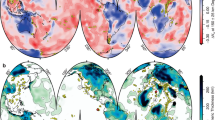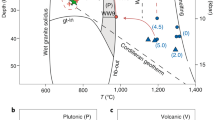Abstract
The processes that lead to the fourfold variation in arc-averaged compositions of mafic arc lavas remain controversial. Control by the mantle-wedge thermal structure is supported by chemical correlations with the thickness of the underlying arc crust1,2,3, which affects the thermal state of the wedge. Control by down-going slab temperature is supported by correlations with the slab thermal parameter3,4,5,6,7. The Chilean Southern Volcanic Zone provides a test of these hypotheses. Here we use chemical data to demonstrate that the Southern Volcanic Zone and global arc averages define the same chemical trends, both among elements and between elements and crustal thickness. But in contrast to the global arc system, the Southern Volcanic Zone is built on crust of variable thickness with a constant slab thermal parameter. This natural experiment, along with a set of numerical simulations, shows that global arc compositional variability is dominated by different extents of melting that are controlled by the thermal structure of the mantle wedge. Slab temperatures play a subordinate role. Variations in the subducting slab’s fluid flux and sediment compositions, as well as mantle-wedge heterogeneities, produce second-order effects that are manifested as distinctive trace element and isotopic signatures; these can be more clearly elucidated once the importance of wedge thermal structure is recognized.
This is a preview of subscription content, access via your institution
Access options
Subscribe to this journal
Receive 12 print issues and online access
$259.00 per year
only $21.58 per issue
Buy this article
- Purchase on Springer Link
- Instant access to full article PDF
Prices may be subject to local taxes which are calculated during checkout



Similar content being viewed by others
References
Plank, T. & Langmuir, C. H. An evaluation of the global variations in the major element chemistry of arc basalts. Earth Planet. Sci. Lett. 90, 349–370 (1988).
Turner, S. J. & Langmuir, C. H. The global chemical systematics of arc front stratovolcanoes: evaluating the role of crustal processes. Earth Planet. Sci. Lett. 422, 182–193 (2015).
Turner, S. J. & Langmuir, C. H. What processes control the chemical compositions of arc front stratovolcanoes? Geochem. Geophys. Geosyst. 16, 1865–1893 (2015).
Cooper, L. B. et al. Global variations in H2O/Ce: 1. Slab surface temperatures beneath volcanic arcs. Geochem. Geophys. Geosyst. 13, Q03024 (2012).
Plank, T., Cooper, L. B. & Manning, C. E. Emerging geothermometers for estimating slab surface temperatures. Nat. Geosci. 2, 611–615 (2009).
Ruscitto, D. M., Wallace, P. J., Cooper, L. B. & Plank, T. Global variations in H2O/Ce: 2. Relationships to arc magma geochemistry and volatile fluxes. Geochem. Geophys. Geosyst. 13, Q03025 (2012).
Gazel, E. et al. Continental crust generated in oceanic arcs. Nat. Geosci. 8, 321–327 (2015).
Plank, T. & Langmuir, C. H. Tracing trace elements from sediment input to volcanic output at subduction zones. Nature 362, 739–743 (1993).
Elliott, T., Plank, T., Zindler, A., White, W. & Bourdon, B. Element transport from slab to volcanic front at the Mariana arc. J. Geophys. Res. 102, 14991–15019 (1997).
McCulloch, M. T. & Gamble, J. Geochemical and geodynamical constraints on subduction zone magmatism. Earth Planet. Sci. Lett. 102, 358–374 (1991).
Kirby, S. H., Durham, W. B. & Stern, L. A. Mantle phase changes and deep-earthquake faulting in subducting lithosphere. Science 252, 216–225 (1991).
Syracuse, E. M., van Keken, P. E. & Abers, G. A. The global range of subduction zone thermal models. Phys. Earth Planet. Inter. 183, 73–90 (2010).
Plank, T., Kelley, K. A., Zimmer, M. M., Hauri, E. H. & Wallace, P. J. Why do mafic arc magmas contain ∼4 wt% water on average? Earth Planet. Sci. Lett. 364, 168–179 (2013).
England, P., Engdahl, R. & Thatcher, W. Systematic variation in the depths of slabs beneath arc volcanoes. Geophys. J. Int. 156, 377–408 (2004).
Syracuse, E. M. & Abers, G. A. Global compilation of variations in slab depth beneath arc volcanoes and implications. Geochem. Geophys. Geosyst. 7, Q05017 (2006).
Hermann, J. & Rubatto, D. Accessory phase control on the trace element signature of sediment melts in subduction zones. Chem. Geol. 265, 512–526 (2009).
van Keken, P. E., Hacker, B. R., Syracuse, E. M. & Abers, G. A. Subduction factory: 4. Depth-dependent flux of H2O from subducting slabs worldwide. J. Geophys. Res. 116, B01401 (2011).
Tassara, A. & Echaurren, A. Anatomy of the Andean subduction zone: three-dimensional density model upgraded and compared against global-scale models. Geophys. J. Int. 189, 161–168 (2012).
Hildreth, W. & Moorbath, S. Crustal contributions to arc magmatism in the Andes of central Chile. Contrib. Mineral. Petrol. 98, 455–489 (1988).
Tormey, D. R., Hickey-Vargas, R., Frey, F. A. & López-Escobar, L. Recent lavas from the Andean volcanic front (33 to 42° S); interpretations of along-arc compositional variations. Geol. Soc. Am. Spec. Pap. 265, 57–78 (1991).
Hickey, R. L., Frey, F. A., Gerlach, D. C. & Lopez-Escobar, L. Multiple sources for basaltic arc rocks from the southern volcanic zone of the Andes (34–41° S): trace element and isotopic evidence for contributions from subducted oceanic crust, mantle, and continental crust. J. Geophys. Res. 91, 5963–5983 (1986).
Jacques, G. et al. Geochemical variations in the Central Southern Volcanic Zone, Chile (38–43° S): the role of fluids in generating arc magmas. Chem. Geol. 371, 27–45 (2014).
van Keken, P. E. et al. A community benchmark for subduction zone modeling. Phys. Earth Planet. Inter. 171, 187–197 (2008).
England, P. C. & Katz, R. F. Melting above the anhydrous solidus controls the location of volcanic arcs. Nature 467, 700–703 (2010).
Lallemand, S., Heuret, A. & Boutelier, D. On the relationships between slab dip, back-arc stress, upper plate absolute motion, and crustal nature in subduction zones. Geochem. Geophys. Geosyst. 6, Q09005 (2005).
Jarrard, R. D. Relations among subduction parameters. Rev. Geophys. 24, 217–284 (1986).
Yogodzinski, G. M. et al. The role of subducted basalt in the source of island arc magmas: evidence from seafloor lavas of the western Aleutians. J. Petrol. 56, 441–492 (2015).
Wilson, C. R., Spiegelman, M., van Keken, P. E. & Hacker, B. R. Fluid flow in subduction zones: the role of solid rheology and compaction pressure. Earth Planet. Sci. Lett. 401, 261–274 (2014).
Class, C., Miller, D. M., Goldstein, S. L. & Langmuir, C. H. Distinguishing melt and fluid subduction components in Umnak Volcanics, Aleutian Arc. Geochem. Geophys. Geosyst. 1, 1004 (2000).
Plank, T. & Langmuir, C. The chemical composition of subducting sediment and its consequences for the crust and mantle. Chem. Geol. 145, 325–394 (1998).
Pfeifer, H.-R., Lavanchy, J.-C. & Serneels, V. Bulk chemical analysis of geological and industrial materials by X-ray fluorescence, recent developments and application to materials rich in iron oxide. J. Trace Microprobe Tech. 9, 127–147 (1991).
Turner, S. J., Izbekov, P. & Langmuir, C. The magma plumbing system of Bezymianny Volcano: insights from a 54 year time series of trace element whole-rock geochemistry and amphibole compositions. J. Volcanol. Geotherm. Res. 263, 108–121 (2013).
Reubi, O. et al. Assimilation of the plutonic roots of the Andean arc controls variations in U-series disequilibria at Volcan Llaima, Chile. Earth Planet. Sci. Lett. 303, 37–47 (2011).
Dungan, M. A., Wulff, A. & Thompson, R. Eruptive stratigraphy of the Tatara–San Pedro complex, 36 S, Southern Volcanic Zone, Chilean Andes: reconstruction method and implications for magma evolution at long-lived arc volcanic centers. J. Petrol. 42, 555–626 (2001).
Jicha, B. R. et al. Rapid magma ascent and generation of 230Th excesses in the lower crust at Puyehue–Cordón Caulle, Southern Volcanic Zone, Chile. Earth Planet. Sci. Lett. 255, 229–242 (2007).
Tagiri, M., Moreno, H., López-Escobar, L. & Notsu, K. Two magma types of the high-alumina basalt series of Osorno Volcano, Southern Andes (41° 06′ S)-Plagioclase dilution effect, Ganko. J. Miner. Petrol. Econ. Geol. 88, 359–371 (1993).
Tormey, D. R., Frey, F. A. & Lopez-Escobar, L. Geochemistry of the active Azufre–Planchon–Peteroa Volcanic Complex, Chile (35° 15′ S): evidence for multiple sources and processes in a Cordilleran arc magmatic system. J. Petrol. 36, 265–298 (1995).
Gerlach, D. C., Frey, F. A., Moreno-Roa, H. & Lopez-Escobar, L. Recent volcanism in the Puyehue—Cordon Caulle Region, Southern Andes, Chile (40 ⋅ 5° S): petrogenesis of evolved lavas. J. Petrol. 29, 333–382 (1988).
Rodriguez, C., Sellé, D., Dungan, M., Langmuir, C. & Leeman, W. Adakitic dacites formed by intracrustal crystal fractionation of water-rich parent magmas at Nevado de Longavi Volcano (36.2° S; Andean Southern Volcanic Zone, Central Chile). J. Petrol. 48, 2033–2061 (2007).
Weill, D. F. & Drake, M. J. Europium anomaly in plagioclase feldspar: experimental results and semiquantitative model. Science 180, 1059–1060 (1973).
Acknowledgements
We wish to acknowledge the invaluable assistance and guidance of D. Sellés and Servicio Nacional de Geología y Minería of Chile for assisting with our field campaigns. R. Hickey-Vargas provided us with many of the samples used in this study as well. Z. Chen carried out some of the ICPMS analyses and provided analytical assistance for the rest. L. Cooper provided discussions and scientific input during our joint sampling expeditions and in the years following, and also took on a large amount of the sample preparation. A helpful review by G. Yogodzinski significantly improved this manuscript. This work was supported by NSF grant EAR-0948511, NERC grant NE/M000427/1, and ERC grant 279925.
Author information
Authors and Affiliations
Contributions
C.H.L. conceived the SVZ as a natural experiment and obtained the funding. S.J.T., S.E., C.H.L. and M.A.D. collected samples. S.J.T. and S.E. acquired the data. S.J.T., C.H.L. and M.A.D. interpreted the chemical data. S.J.T. carried out the geochemical modelling. R.F.K. wrote the numerical code and guided S.J.T. in its application. S.J.T. wrote the manuscript with assistance from C.H.L.; M.A.D. and R.F.K. helped develop and revise the manuscript.
Corresponding author
Ethics declarations
Competing interests
The authors declare no competing financial interests.
Supplementary information
Supplementary Information
Supplementary Information (PDF 424 kb)
Supplementary Information
Supplementary Information (XLSX 273 kb)
Rights and permissions
About this article
Cite this article
Turner, S., Langmuir, C., Katz, R. et al. Parental arc magma compositions dominantly controlled by mantle-wedge thermal structure. Nature Geosci 9, 772–776 (2016). https://doi.org/10.1038/ngeo2788
Received:
Accepted:
Published:
Issue Date:
DOI: https://doi.org/10.1038/ngeo2788
This article is cited by
-
Magmatic evolution of the migrating central Urumieh–Dokhtar arc, Iran: implications for magma production
International Journal of Earth Sciences (2023)
-
High-K andesites as witnesses of a continental arc system in the Western Alps, Italy: constraints from HFSE and Hf–Nd–Sr–Pb–O isotope systematics
Contributions to Mineralogy and Petrology (2023)
-
Sulfur and chlorine budgets control the ore fertility of arc magmas
Nature Communications (2022)
-
Basalt derived from highly refractory mantle sources during early Izu-Bonin-Mariana arc development
Nature Communications (2021)
-
Subduction erosion and arc volcanism
Nature Reviews Earth & Environment (2020)



